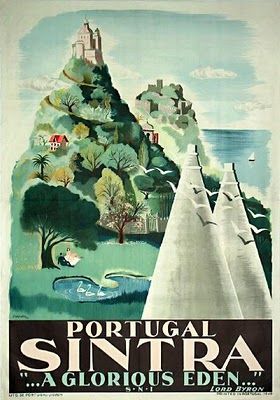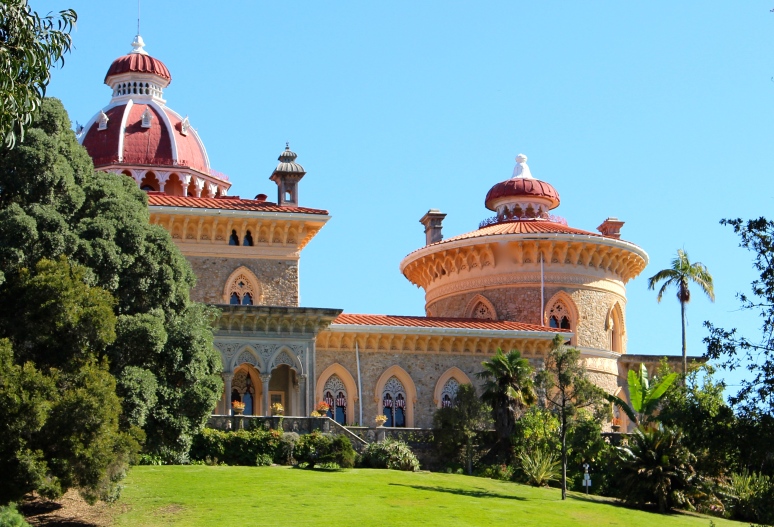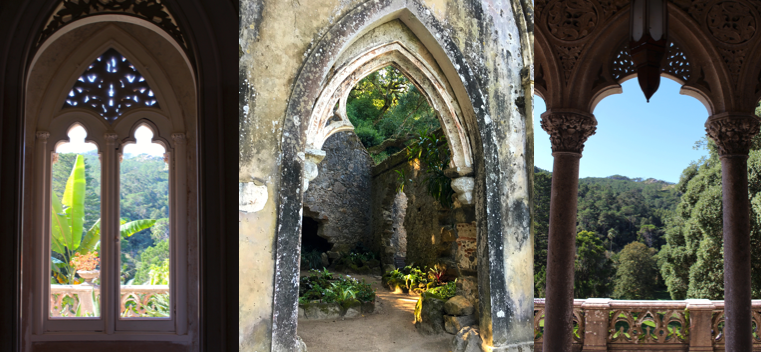The Gardens of Monserrate: Portugal

Located in the hills of Sintra, Portugal, the palace and gardens of Monserrate are truly magical. Reminiscent of childhood fantasies about exotic far away places, they were developed over centuries through the creative genius of multiple individuals and are described as one of the most beautiful landscapes created in the Romantic era in Portugal as well as the most important English landscape gardens beyond the British Isles.

View of Monserrate in 1840 Lithography by Manuel Luiz based on a drawing by Clémentine Brélaz. © Parques de Sintra-Monte da Lua, S.A.
I visited Monserrate in early October while on a two-week trip to Portugal. A world heritage cultural landscape, Sintra has for centuries served as a vacation destination for the Portuguese elite. Encompassing some of Portugal’s most important parks and monuments, including the Park and Palace of Pena, Sintra is often visited as a day trip from Lisbon although I chose to spend three days exploring the region.

The history of Monserrate is as romantic as its landscape, a tale of creation, abandonment and rediscovery.

In 1540 a chapel dedicated to Our Lady of Monserrate was erected on the site, for which it is named. By the 17th century the property passed to the influential Mello e Castro family and by 1790 it was acquired by Gerard de Visme a wealthy merchant who built a neo-Gothic palace atop the ruins of the former chapel.

View of the property of Gerard de Visme (drawing by Noel, c.1790; print by J.Wells, 1795 – National Library of Portugal
According to a history of Monserrate, Visme’s gardens were remarkable and based upon an English model that differed from the baroque gardens favored in Portugal at the time. Most unusual was a preoccupation with the design of carefully considered views of “natural curiosities” including grottoes and streams. Artistic elements included an obelisk and a hermitage.

Enter William Beckford, an eccentric travel writer and the author of the gothic novel Vathek subtitled An Arabian Tale or The History of the Caliph Vathek. Beckford first visited the property in 1794 and during a fourteen year tenure at Monserrate created a romantic landscape in the “picturesque manner.”

At Monserrate Beckford is credited with diverting a stream on the property to create Beckford’s Waterfall, constructing Vathek’s stone arch (seen below) and numerous planting projects including the introduction of two stone pines planted on either side of the waterfall.

By 1809 the property had fallen into disrepair and Byron, a fan of the book Vathek, visited and wrote a poem describing what was by then an abandoned landscape. His romantic description of the palace and grounds as a ruin made Monserrate a popular destination for English visitors drawn to its decaying splendor.

In 1856 the Cook family purchased the property and it is they who are credited with transforming Monserrate into the extraordinary palace and gardens which exist today. A textile millionaire, Cook hired more than 2,000 men to work for more than five years to rebuild the house and gardens.

The Cook family and friends
According to a history published by the Parques de Sintra, Cook “wanted a house that would be visited twice a year, for periods of about a month, not a country house but a holiday home.” Cook’s palace combined Victorian influences with Italian gothic details, orientalism and Portuguese elements. The ornate interiors are beautiful and the palace, although currently devoid of furnishings, remains a work of art.


The Cook family lived at Monserrate for four generations. During their tenure the gardens were gradually landscaped in the picturesque manner and in harmony with the palace as distinct scenes “worthy of being painted.”


As one travels throughout the gardens the Palace remains a central and surprising visual feature emerging from multiple perspectives along the steeply sloped, densely vegetated, circuitous paths. The interplay of natural and formal elements is evident throughout.

A view of the palace dated 1866
Arriving at the garden one is greeted by two Chimera, fire-breathing mythological creatures that represent that which is hoped for but is illusory and impossible to achieve. They introduce the visitor to the “fantastic beyond the garden gates.”


Upon entering Monserrate there are few visual clues about which path to take and where the palace lies. I was drawn towards the sound of Beckford’s waterfall which led downhill to both the fern valley and chapel which was rebuilt by Cook as a “ruin” on the site of one built by Gerard de Visme to replace the former chapel of Our Lady of Monserrate.
This sequence is described in the guide as representing that of a wanderer who sets off on an unknown journey and is guided by nature itself.


Approximately 80 acres in size, Monserrate contains an extensive botanical collection from throughout the world that is showcased in a series of themed gardens that flourish in Sintra’s temperate climate.

Among these is a large Mexican garden containing collections of plants from warm climates including palms, yuccas, nolinas, agaves and cycads. Restored in 2010 it is in the hottest and driest part of Monserrate and is one of its largest.



I was drawn to a series of gardens located to the side of the palace and accessible from the porch. Here a series of steps leads to a path bordered by pergolas planted with wisteria and jasmine. 
An ornamental Indian Arch purchased in 1857 by Sir Francis Cook from Charles Canning, the Governor-General of India, leads from this area to the Boulder House which once housed a carpenter’s shop and cow shed and is now used as the head offices of Parques de Sintra-Monte da Lua.


Close by is the Cromlech, a term that describes prehistoric megalithic structures (think Stonehenge), which is attributed to Beckford.

In 1949, Monserrate was purchased by the Portuguese State and in 1995 it was included in the Cultural Landscape of Sintra, classified by UNESCO as a World Heritage Site.

In 2000 management of the estate was transferred to Parques de Sintra, which continues to restore the gardens and Palace. Their work was recognized in 2013 when the Park of Monserrate was awarded a European Garden Award under the category of Best Development of a Historic Park or Garden.
Copyright © 2016 Patrice Todisco — All Rights Reserved















Beautiful pix Patrice! Looks like a great trip. I didn’t see anything like this in the Azores.
Love this place!